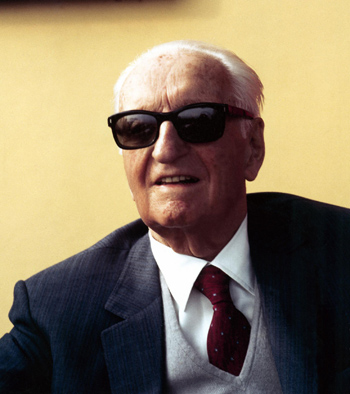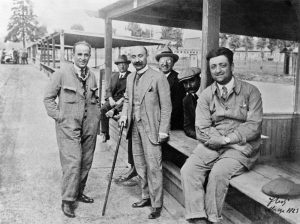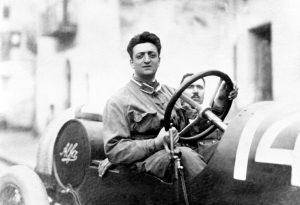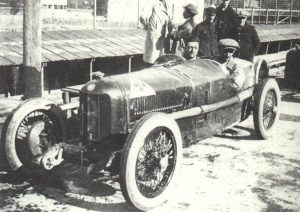
Enzo Ferrari was born in Modena on February 18th 1898 and died on August 14th 1988. He devoted his entire life to designing and building sports cars and, of course, to the track.
In 1908, Ten year old Enzo and his brother Alfredo are brought by their father to watch a race at the motor racing circuit on Via Emilia in Bologna. The race is won by Felice Nazzaro (Vincenzo Lancia took the race fastest lap). Young Enzo is completely entranced by the action. The Ferrari family is hit by a double tragedy in 1916 as both Enzo’s father and brother pass away. Enzo is forced to give up his studies after his father’s death and finds work as an instructor in the lathing school at the fire service workshop in Modena.
1917, Enzo serves in the Italian army during the First World War and is assigned to the 3rd Alpine Artillery Division. However, he becomes seriously ill and undergoes two operations before being honourably discharged. Once he regains his health, Ferrari attempts to get a job with Fiat in Turin but to no avail. At the end of 1918, he does, however, find work as a test-driver at a small company in Turin that builds the much-sought after Torpedos which were built on a light truck chassis.
In 1919, Enzo moves to Milan to work for C.M.N (Costruzioni Meccaniche Nazionali), first as a test-driver and then later as a racing driver. He makes his competitive debut in the 1919 Parma-Poggio di Berceto hillclimb race in which he finishes fourth in the three-litre category at the wheel of a 2.3-litre 4-cylinder CMN 15/20. On November 23rd of the same year, he takes part in the Targa Florio but loses over 40 minutes after his car’s fuel tank develops a leak.
In 1920, after a series of races in which he enjoys mixed fortunes at the wheel of an Isotta Fraschini 100/110 IM Corsa, Enzo finishes second in the Targa Florio in a 6-litre 4-cylinder Alfa Romeo Tipo 40/60. This marks the start of a 20-year collaboration with the marque that will see Ferrari do everything from test-driving to racing to dealing before finally being appointed head of the Alfa Corse racing division, a position he holds until September 1939.

1921, Ferrari competes in several races as an official Alfa driver, delivering some impressive finishes such as a fifth position in the Targa Florio in May and a second at Mugello in July. He also has his first major accident in September that year when he goes off the road on the eve of the Brescia Grand Prix trying to avoid a herd of cattle blocking the race route. Ferrari wins the first Circuito del Savio and meets Count Baracca, father of the famous Italian First World War pilot Francesco Baracca. He later meets Countess Baracca who gives him a signed photograph and invites him to use her son’s Prancing Horse emblem as a mascot on his cars.
In 1924 Enzo Ferrari is made a Cavaliere (Knight) for his sporting achievements, his first official honor from the Italian state. He is made a Cavaliere Ufficiale in 1925. His passion for journalism sees him become one of the founders of the famous Corriere dello Sport newspaper in Bologna that same year too.
1927, Ferrari is made Commendatore by the Italian state in recognition of his services to the Nation in the area of racing. On June 5th of the same year, he wins the first Circuito di Modena in an Alfa Romeo 6C-1500 SS.
On May 20th 1928, Enzo wins the 2nd Circuito di Modena, once again at the wheel of an Alfa Romeo 6C- 1500 SS.
In 1929 Ferrari founds the Scuderia Ferrari on Viale Trento Trieste in Modena which assisted mostly gentlemen drivers in racing their cars.. The main aim of this racing “stable” is to allow owner-drivers to race. Its foundation marks the start of a burst of frenetic sporting activity that will lead to the creation of an official team. The Scuderia fielded both cars (mainly Alfas) and motorbikes.
In time it becomes a technical-racing outpost of Alfa Romeo and effectively takes over as its racing department in 1933.
Enzo Ferrari completes his final race as a driver at the Circuito Tre Province on August 9th 1931. He finishes second to Nuvolari in an Alfa Romeo 8C -2300 MM. The decision to quit racing comes as result of the impending birth of his son Alfredo, better known as Dino (19th January 1932), and his growing workload as head of the Scuderia.
In 1937, the Scuderia Ferrari builds the Alfa Romeo 158 “Alfetta” which goes on to dominate the international racing scene. The Scuderia Ferrari is wound up at the end of 1937 and at the beginning of 1938 Enzo Ferrari takes up his new position as head of Alfa Corse and moves to Milan.
On September 6th 1939, Enzo Ferrari leaves Alfa Romeo under the proviso that he does not use the Ferrari name in association with races or racing cars for at least four years. From that moment on, beating Alfa Romeo in one of his own cars becomes a passion. On September 13th Ferrari opens Auto Avio Costruzioni on Viale Trento Trieste in Modena, the headquarters of the old Scuderia Ferrari.

In 1940, Auto Avio Costruzioni builds two versions of what Ferrari calls the 815 (8 cylinders, 1500 cc) on a Fiat platform for the last pre-War Mille Miglia. They are driven by a young Alberto Ascari and Marquis Lotario Rangoni Machiavelli of Modena but fail to shine. The Auto Avio Costruzioni 815 was the first car to be fully designed and built by Enzo Ferrari and successor to the Ferrari 125 S.
At the very height of the War in 1943, Auto Avio Costruzioni moves out of Modena to Maranello where the first part of what would later become the Ferrari factory is built. In Modena, the company had worked for the National Aeronautical Company of Rome, Piaggio and RIV, but in Maranello the focus is mostly on fabricating grinding machines which were copies of original German tooling machines. The factory is first bombed on November 4th 1944 and then hit again the following February but is quickly rebuilt.

In 1945 Ferrari begins work on designing the first Ferrari in late 1945. His ambitious plan is to power it with a V12 engine. In fact, this particular architecture would become a fixture throughout the company’s entire history. The reason Ferrari chosen a V12 was its versatility: it was just as suited to use on sports prototypes as single-seaters and even Grand Tourers.
In December 1946, Ferrari releases specifications and drawings of his new car to the press. On March 12th 1947, he takes the car, now known as the 125 S, out for its first test-drive on the open road.
Having won its first Mille Miglia in 1948, its first Le Mans 24 Hour Race in 1949 and its first Formula 1 World Championship Grand Prix in 1951, Ferrari becomes world Champions for first time in 1952 thanks to Alberto Ascari who repeats his feat the following year.
In 1956, Enzo’s beloved son, Alfredo, or Dino as he was better known, dies of muscular dystrophy. Ferrari had kept his son involved in the design of a new 1500 cc V6 until the very end of his life. The engine finally debuts 10 months after Dino’s death. However, it and all Ferrari V6 engines are named in his honour.
In 1960, Ferrari becomes a Limited Liability Company and Enzo is conferred with an Honorary Degree in Mechanical Engineering by Bologna University.
In 1962, Enzo Ferrari is presented with the Hammarskjöld Prize by the United Nations.
1963 sees Enzo Ferrari build the professional industry and artisanship training institute in Maranello. Dedicated to Alfredo “Dino” Ferrari, it continues to provide the company with special technicians to this day. 1965, Enzo Ferrari wins the Columbus Prize.
1969, Ferrari becomes aware that he requires a powerful partner if the company is to continue to develop and so signs an agreement with the Fiat Group giving it a 50% stake in the company shares.
Enzo Ferrari decides to build the Fiorano Circuit which will be officially opened on April 8th 1972.
In 1987, The F40, the last car to be created under Enzo Ferrari’s management, is unveiled.
Enzo Ferrari passes away in Modena at the age of 90 in August 1988.




You must be logged in to post a comment.